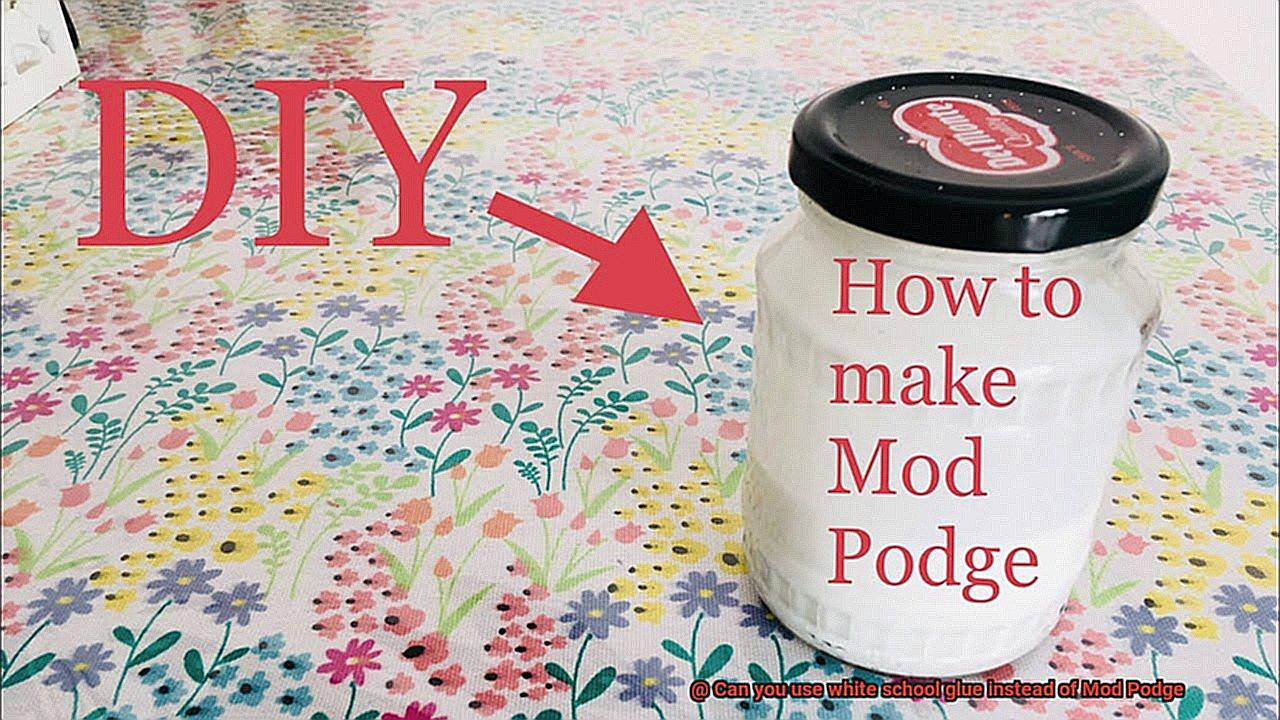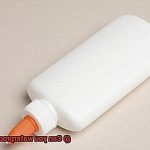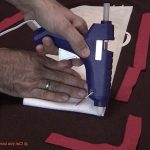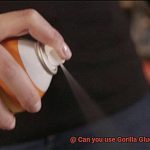Are you a crafting enthusiast who loves to experiment with different materials and techniques? If so, you’ve probably come across Mod Podge, the versatile crafting adhesive that seems to be everywhere these days. It’s perfect for decoupage, collage, and all sorts of other projects – but what if you run out?
Before you panic and rush to the store, take a look in your own arts and crafts stash. You might already have a suitable alternative: white school glue. Yes, that’s right – the same stuff you used in elementary school could be just what you need.
But can you really use white school glue instead of Mod Podge? It’s a question that many crafters have asked, and the answer is not as simple as yes or no. In this post, we’ll explore the differences between these two adhesives and help you decide which one is best for your project.
Whether you’re working on a DIY home decor project or creating handmade gifts for friends and family, we’ve got tips and tricks to help you make the most of your materials. So grab your glue bottle and let’s get started.
What is Mod Podge?
Contents
- 1 What is Mod Podge?
- 2 What is White School Glue?
- 3 The Similarities Between Mod Podge and White School Glue
- 4 The Differences Between Mod Podge and White School Glue
- 5 Tips for Using White School Glue as a Replacment for Mod Podge
- 6 Pros and Cons of Using White School Glue Instead of Mod Podge
- 7 Alternatives to Both Mod Podge and White School Glue
- 8 Conclusion
This water-based sealer, glue, and finish all in one has been around for over 40 years and has become a popular choice for artists and DIY enthusiasts alike. Made by Plaid Enterprises, Inc., Mod Podge is the go-to adhesive for decoupage and other art projects.
Mod Podge is a versatile glue that comes in a variety of formulas including gloss, matte, satin, glitter, and more, making it perfect for a wide range of projects. One of the benefits of Mod Podge is that it dries clear and has a smooth finish, creating a professional-looking result every time.
Using Mod Podge is easy and straightforward. Simply apply it with a brush or sponge applicator and wait for it to dry. If any mistakes are made, the glue can be cleaned up with soap and water. Plus, Mod Podge is non-toxic and safe for children to use.
In addition to its versatility and ease of use, Mod Podge can also be used as a protective topcoat for painted surfaces. This makes it ideal for sealing surfaces that will be used daily such as coasters or trays.
Mod Podge is known for its ability to create a smooth and glossy finish on a variety of surfaces such as paper, wood, fabric, and more. It can also be used as a glue to adhere materials together. The various formulas of Mod Podge allow artists to choose the perfect finish for their projects whether they want a high-gloss shine or a subtle satin finish.
But what if you don’t have access to Mod Podge or prefer to use an alternative? While white school glue can work as a replacement for Mod Podge, there are some differences between the two adhesives that you should keep in mind. For example, Mod Podge has a thicker consistency than white school glue which can make it easier to apply on certain surfaces. Additionally, Mod Podge has a slightly different formula that allows it to adhere better to certain materials like fabric and paper.
What is White School Glue?
White school glue, also known as PVA (polyvinyl acetate) glue, is a beloved adhesive that has been used in classrooms and households for generations. As an expert in this field, I can tell you that this water-based, non-toxic glue is a staple for students and teachers alike. But what makes white school glue so special?
Firstly, its ability to bond porous materials like paper and cardboard together is unmatched. This versatile adhesive can be used for a wide range of applications such as creating collages, scrapbooking, and even making slime. It dries clear too, making it an ideal choice for various craft projects.
In addition to its artistic uses, white school glue can also come in handy for practical purposes. Need to repair torn pages in books or fix broken toys? White school glue has got you covered.
Another benefit of white school glue is its affordability and accessibility. It can be easily found at most craft stores and supermarkets, making it a budget-friendly option. Plus, if any spills or mistakes occur during use, it can be easily cleaned up with water.
The Similarities Between Mod Podge and White School Glue
Two popular options that often come up in discussions are Mod Podge and white school glue. While both adhesives offer unique benefits, they also share some similarities.
One of the main similarities between Mod Podge and white school glue is their chemical composition. Both adhesives contain polyvinyl acetate (PVA) as their primary ingredient. This water-soluble polymer makes them ideal for various crafting projects, such as decoupage, collage, and paper mache.
In addition to their chemical composition, Mod Podge and white school glue also share similar consistency and viscosity when applied. They both flow smoothly onto surfaces and are easy to work with. Furthermore, they are non-toxic and safe for children to use.
However, it’s important to note that not all types of white school glue are suitable for all crafting projects. Some may dry too quickly or become brittle over time, which can affect the overall quality of your finished product. On the other hand, Mod Podge offers different variations that provide glossy, matte, or satin finishes.
When deciding between Mod Podge and white school glue, it’s crucial to consider the specific requirements of your project. Do you need a glossy or matte finish? Will the adhesive dry too quickly? By evaluating these factors, you can determine which adhesive will best suit your needs.
The Differences Between Mod Podge and White School Glue
Let’s take a closer look.
One of the most significant differences between Mod Podge and white school glue is their consistency. Mod Podge is thick and durable, making it ideal for bonding a variety of surfaces, including fabric, metal, and plastic. In contrast, white school glue is thinner and more suitable for paper-based crafts like scrapbooking or card making.
However, the most noticeable difference between these two glues is how they dry. Mod Podge dries clear and produces a glossy finish that enhances the colors of your project. This finish is perfect for projects where you want a professional, high-quality look. In contrast, white school glue may dry with a cloudy appearance that can dull the colors of your project.
Another critical factor in choosing the right glue for your project is adhesive strength. Mod Podge is formulated to create a durable hold that can withstand wear and tear over time. It has stronger adhesive properties than white school glue, which may not be suitable for projects that require strong bonding capabilities.
Tips for Using White School Glue as a Replacment for Mod Podge
Crafting and DIY projects are a great way to unleash your creativity. Mod Podge is a popular adhesive used in these projects, but it may not always be readily available or budget-friendly. Fortunately, white school glue can be used as a replacement for Mod Podge, and here are some tips and tricks to help you get the best results.
Dilute the glue
To achieve a consistency similar to Mod Podge, mix equal parts white school glue and water. This mixture will make it easier to apply and give your project a smoother finish. Be sure to mix the two ingredients well before applying to your project.
Use a sealant
Unlike Mod Podge, white school glue is not waterproof. To protect your project from moisture or humidity, consider using a sealant spray or brushing on a clear coat of acrylic sealer. This will ensure that your project lasts longer and stays in good condition.
Be patient
White school glue takes longer to dry than Mod Podge, so be prepared to wait several hours or even overnight for your project to fully dry. Rushing the drying process can cause unwanted wrinkles or bubbles in your project.

Experiment with different types of paper
While Mod Podge is known for its ability to adhere various types of paper, white school glue may have a harder time sticking to heavier or glossy paper. Try experimenting with different types of paper to see what works best with this adhesive. You may need to apply more coats of the glue mixture for better adhesion.
Apply the glue mixture evenly and thinly
Too much glue can cause paper to warp or wrinkle, so make sure to apply the glue mixture evenly and thinly. A foam brush or sponge brush is ideal for applying the mixture smoothly without leaving brush marks or streaks.
Pros and Cons of Using White School Glue Instead of Mod Podge
While Mod Podge may be the household name, there are pros and cons to using white school glue instead.
Let’s start with the pros. Firstly, white school glue is a lot cheaper than Mod Podge, making it an excellent option for those on a tight budget or wanting to save money on crafting supplies. Secondly, it’s widely available in almost every stationery store, craft store, and even supermarkets, making it easily accessible. Lastly, white school glue has similar properties to Mod Podge – both are water-based, easy to clean up, and dry clear. This means that white school glue can be used in place of Mod Podge for many different projects.
However, there are also some cons to using white school glue instead of Mod Podge. Firstly, it may not be as strong as Mod Podge. While it’s sufficient for basic crafting projects, it may not hold up as well with heavier materials or when a stronger bond is required. Secondly, white school glue has limited uses and is only suitable for basic paper crafts. It can’t be used as a sealant for outdoor projects or to protect furniture. Lastly, it takes longer to dry than Mod Podge. If you’re working on a project with a tight deadline, you may want to opt for Mod Podge instead.
Alternatives to Both Mod Podge and White School Glue
Crafting is an art form that requires the right tools and materials to bring your vision to life. When it comes to adhesives, Mod Podge and white school glue are go-to choices for many crafters. However, there are times when these options may not be available or suitable for the project at hand. That’s when it’s crucial to know about alternatives to both Mod Podge and white school glue.
One alternative that can provide a clear and glossy finish is clear acrylic sealer spray. This spray can be used as a sealant for a variety of materials, including paper, fabric, and wood. It dries clear and provides a professional-looking finish that is similar to Mod Podge. However, keep in mind that it does not have the same adhesive properties as Mod Podge or white school glue and may not work well for projects that require a strong bond.
For attaching lightweight embellishments such as paper or stickers, double-sided tape or glue dots are mess-free options that are easy to use. They don’t leave any residue behind and can be removed easily if needed. However, they may not be strong enough for heavier materials or items that need to withstand wear and tear.
If you’re working on heavy-duty projects, epoxy glue or super glue can be reliable alternatives to Mod Podge or white school glue. These adhesives provide a strong bond and can be used on a variety of materials including metal, plastic, and ceramic. They are perfect for projects that require durability and strength. However, they can be challenging to work with and may require some practice to get the desired results.
There are also other alternatives such as rubber cement, clear nail polish, and even corn syrup mixed with water. Each alternative has its own unique properties and uses – creative experimentation is key to finding the perfect solution for your crafting needs.
2V6ZqdUs4MU” >
Also Read: Is there a Mod Podge Alternative?
Conclusion
In the world of crafting, finding the right adhesive can make or break a project. Two popular options that often come up in discussions are Mod Podge and white school glue. While both have their unique benefits, it’s important to consider their differences before choosing the right adhesive for your project.
Mod Podge is a versatile adhesive that offers a smooth and glossy finish on various surfaces such as paper, wood, and fabric. Its stronger adhesive properties make it ideal for projects that require durability over time. In contrast, white school glue is affordable and easily accessible, making it perfect for bonding porous materials like paper and cardboard.
While white school glue can work as a replacement for Mod Podge in some cases, it may not be suitable for all crafting projects. Fortunately, there are alternatives such as clear acrylic sealer spray, double-sided tape or glue dots, epoxy glue or super glue that can provide strong bonds depending on the specific requirements of your project.
Ultimately, choosing between Mod Podge and white school glue depends on your project’s needs. By evaluating these needs and experimenting with different adhesives, you can find the perfect solution to bring your creative vision to life.






